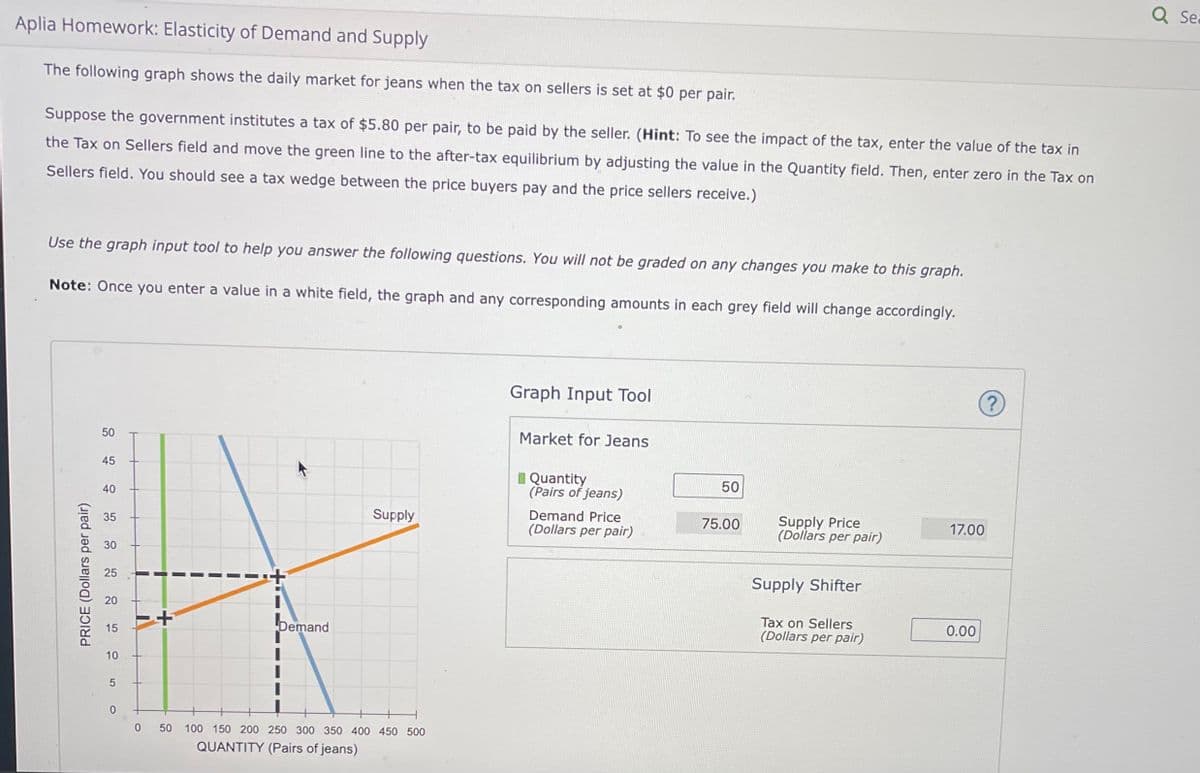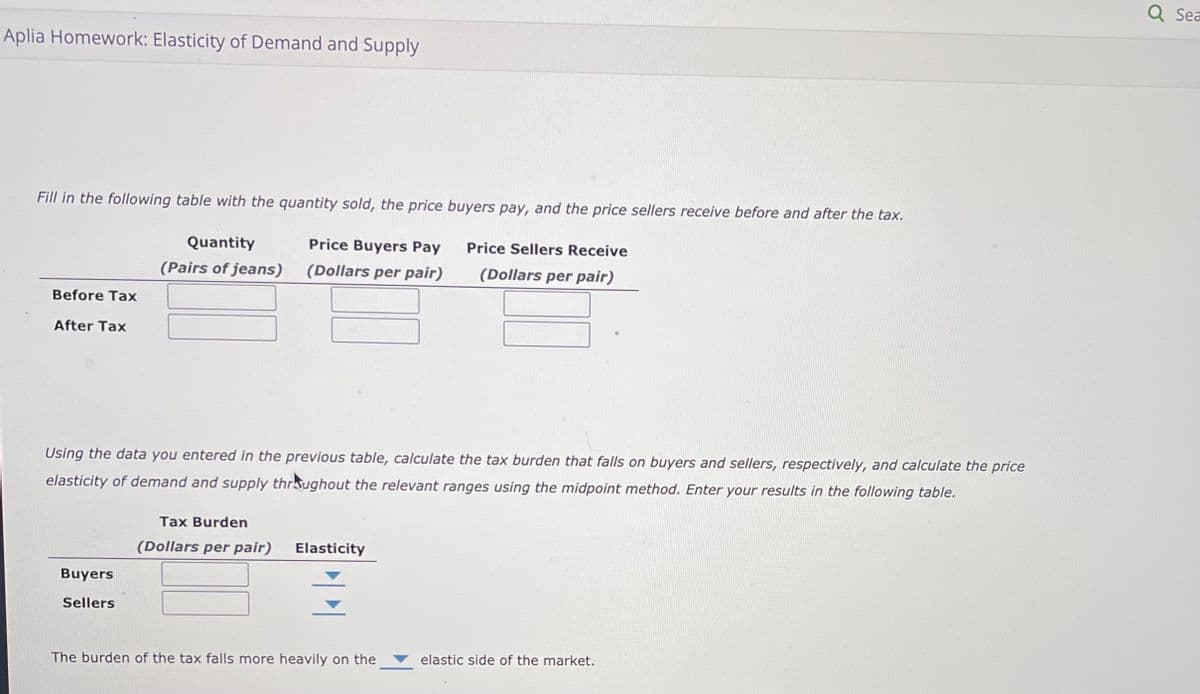lowing graph shows the daily market for jeans when the tax on sellers is set at $0 per pair. se the government institutes a tax of $5.80 per pair, to be paid by the seller. (Hint: To see the impact of the tax, enter the value of the tax in K on Sellers field and move the green line to the after-tax equilibrium by adjusting the value in the Quantity field. Then, enter zero in the Tax on = field. You should see a tax wedge between the price buyers pay and the price sellers receive.) e graph input tool to help you answer the following questions. You will not be graded on any changes you make to this graph. Once you enter a value in a white field, the graph and any corresponding amounts in each grey field will change accordingly. Graph Input Tool 50 Market for Jeans 45 I Quantity (Pairs of jeans) 50 40 Supply Demand Price (Dollars per pair) Supply Price (Dollars per pair) 75.00 17.00 35 30 25 Supply Shifter 20 Tax on Sellers (Dollars per pair) 0.00 Demand 15 10 5 50 100 150 200 250 300 350 400 450 500 QUANTITY (Pairs of jeans)
lowing graph shows the daily market for jeans when the tax on sellers is set at $0 per pair. se the government institutes a tax of $5.80 per pair, to be paid by the seller. (Hint: To see the impact of the tax, enter the value of the tax in K on Sellers field and move the green line to the after-tax equilibrium by adjusting the value in the Quantity field. Then, enter zero in the Tax on = field. You should see a tax wedge between the price buyers pay and the price sellers receive.) e graph input tool to help you answer the following questions. You will not be graded on any changes you make to this graph. Once you enter a value in a white field, the graph and any corresponding amounts in each grey field will change accordingly. Graph Input Tool 50 Market for Jeans 45 I Quantity (Pairs of jeans) 50 40 Supply Demand Price (Dollars per pair) Supply Price (Dollars per pair) 75.00 17.00 35 30 25 Supply Shifter 20 Tax on Sellers (Dollars per pair) 0.00 Demand 15 10 5 50 100 150 200 250 300 350 400 450 500 QUANTITY (Pairs of jeans)
Essentials of Economics (MindTap Course List)
8th Edition
ISBN:9781337091992
Author:N. Gregory Mankiw
Publisher:N. Gregory Mankiw
Chapter5: Elastic And Its Application
Section: Chapter Questions
Problem 6PA: The price of coffee rose sharply last month, while the quantity sold remained the same. Five people...
Related questions
Question

Transcribed Image Text:Q Sea
Aplia Homework: Elasticity of Demand and Supply
The following graph shows the daily market for jeans when the tax on sellers is set at $0 per pair.
Suppose the government institutes a tax of $5.80 per pair, to be paid by the seller. (Hint: To see the impact of the tax, enter the value of the tax in
the Tax on Sellers field and move the green line to the after-tax equilibrium by adjusting the value in the Quantity field. Then, enter zero in the Tax on
Sellers field. You should see a tax wedge between the price buyers pay and the price sellers receive.)
Use the graph input tool to help you answer the following questions. You will not be graded on any changes you make to this graph.
Note: Once you enter a value in a white field, the graph and any corresponding amounts in each grey field will change accordingly.
Graph Input Tool
50
Market for Jeans
45
I Quantity
(Pairs of jeans)
50
40
Supply
Demand Price
(Dollars per pair)
Supply Price
(Dollars per pair)
75.00
17.00
35
30
25
Supply Shifter
Tax on Sellers
(Dollars per pair)
0.00
Demand
15
10
50
100 150 200 250 300 350 400 450 500
QUANTITY (Pairs of jeans)
PRICE (Dollars per pair)
20

Transcribed Image Text:Q Sea
Aplia Homework: Elasticity of Demand and Supply
Fill in the following table with the quantity sold, the price buyers pay, and the price sellers receive before and after the tax.
Quantity
Price Buyers Pay
Price Sellers Receive
(Pairs of jeans)
(Dollars per pair)
(Dollars per pair)
Before Tax
After Tax
Using the data you entered in the previous table, calculate the tax burden that falls on buyers and sellers, respectively, and calculate the price
elasticity of demand and supply thraughout the relevant ranges using the midpoint method. Enter your results in the following table.
Tax Burden
(Dollars per pair)
Elasticity
Buyers
Sellers
The burden of the tax falls more heavily on the
elastic side of the market.
Expert Solution
This question has been solved!
Explore an expertly crafted, step-by-step solution for a thorough understanding of key concepts.
This is a popular solution!
Trending now
This is a popular solution!
Step by step
Solved in 2 steps with 1 images

Knowledge Booster
Learn more about
Need a deep-dive on the concept behind this application? Look no further. Learn more about this topic, economics and related others by exploring similar questions and additional content below.Recommended textbooks for you

Essentials of Economics (MindTap Course List)
Economics
ISBN:
9781337091992
Author:
N. Gregory Mankiw
Publisher:
Cengage Learning

Exploring Economics
Economics
ISBN:
9781544336329
Author:
Robert L. Sexton
Publisher:
SAGE Publications, Inc

Microeconomics: Principles & Policy
Economics
ISBN:
9781337794992
Author:
William J. Baumol, Alan S. Blinder, John L. Solow
Publisher:
Cengage Learning

Essentials of Economics (MindTap Course List)
Economics
ISBN:
9781337091992
Author:
N. Gregory Mankiw
Publisher:
Cengage Learning

Exploring Economics
Economics
ISBN:
9781544336329
Author:
Robert L. Sexton
Publisher:
SAGE Publications, Inc

Microeconomics: Principles & Policy
Economics
ISBN:
9781337794992
Author:
William J. Baumol, Alan S. Blinder, John L. Solow
Publisher:
Cengage Learning

Principles of Macroeconomics (MindTap Course List)
Economics
ISBN:
9781305971509
Author:
N. Gregory Mankiw
Publisher:
Cengage Learning

Principles of Microeconomics
Economics
ISBN:
9781305156050
Author:
N. Gregory Mankiw
Publisher:
Cengage Learning

Principles of Economics 2e
Economics
ISBN:
9781947172364
Author:
Steven A. Greenlaw; David Shapiro
Publisher:
OpenStax